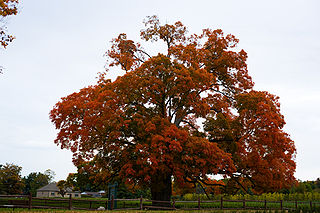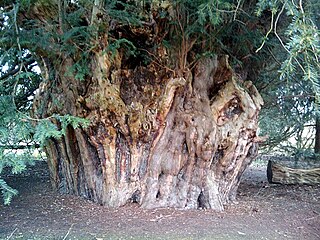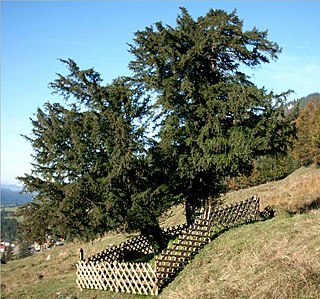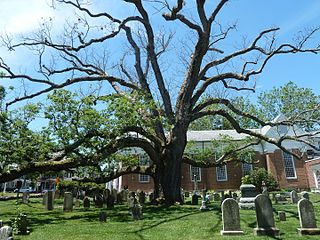
Cangas de Onís is a municipality in the eastern part of the province and autonomous community of Asturias in the northwest of Spain. The capital of the municipality is also Cangas de Onís.

Taxus is a genus of coniferous trees or shrubs known as yews in the family Taxaceae. They are relatively slow-growing and can be very long-lived, and reach heights of 2.5–20 m (8.2–65.6 ft), with trunk girth averaging 5 m (16 ft). They have reddish bark, lanceolate, flat, dark-green leaves 10–40 mm long and 2–3 mm broad, arranged spirally on the stem, but with the leaf bases twisted to align the leaves in two flat rows either side of the stem. The oldest known fossil species are from the Early Cretaceous.

Taxus baccata is a species of evergreen tree in the family Taxaceae, native to western, central and southern Europe, northwest Africa, northern Iran, and southwest Asia. It is the tree originally known as yew, though with other related trees becoming known, it may now be known as common yew, English yew, or European yew. It is primarily grown as an ornamental. Most parts of the plant are poisonous, with toxins that can be absorbed through inhalation and through the skin; consumption of even a small amount of the foliage can result in death.

The Fortingall Yew is an ancient European yew in the churchyard of the village of Fortingall in Perthshire, Scotland. It is known for being one of the oldest trees in Britain, with modern estimates of its age between 2,000 and 3,000 years.

Kingley Vale is a 204.4-hectare (505-acre) biological Site of Special Scientific Interest north of Chichester in West Sussex. It is also a Special Area of Conservation and a Nature Conservation Review site, Grade I. An area of 147.9 hectares is a national nature reserve.

Quirós is a municipality in the Autonomous Community of the Principality of Asturias, Spain. To the southeast is the municipality of Lena, to the south lies the Autonomous Community of León, to the northeast Riosa and Morcín, to the north is Santo Adriano, to the northwest is Proaza, and to the west is Teverga. Castillo de Alba was a notable fortress here in medieval times, today in ruins.

Alcaucin is a town and municipality in the province of Málaga, part of the autonomous community of Andalusia in southern Spain. It borders with the province of Granada. The municipality is situated approximately 54 kilometers to the city of Málaga. It is 507 km from the capital of Madrid. The name was derived from al-kautín, the Arabic of "the arches." It has a population of approximately 1,600 residents, partly living in the hamlet of Puente Don Manuel. Natives of the town are called Alcaucineños and have the nickname of tiznaos.

Llangathen is a community located in Carmarthenshire, Wales. The population taken at the 2011 census was 507.
Càrn na Marbh is a re-used Bronze Age tumulus, located in 56°35′50″N4°03′09″W Fortingall in Perthshire, Scotland. The mound was used in the 14th century for burying victims of the plague away from the church graveyard. A stone, known as Clach a' Phlàigh, "the Plague Stone" crowns the mound and may be an original standing stone and commemorates the plague victims who were buried here in the 14th century. A tablet on the stone is inscribed with the words:
“Here lie the victims of the Great Plague of the 14th Century, taken here on a sledge drawn by a white horse led by an old woman.”
Mamhilad is a village in the community of Goetre Fawr in Monmouthshire, south east Wales.

The Comfort Maple tree is an individual sugar maple located in Comfort Maple Conservation Area in the Town of Pelham, Ontario. The tree is estimated to be about 500 years old. If correct, it would make this one of the oldest sugar maple trees in Canada.

Caesarsboom is a very old tree whose precise age is unknown but is believed to be over 2000 years in age. The ancient tree grows in Lo, a town in Lo-Reninge, a municipality of the province of West-Vlaanderen of Belgium. Its species is Taxus baccata, common name European Yew. The tree is designated a national monument of Belgium.

Bermiego is one of thirteen parishes in Quirós, a municipality within the province and autonomous community of the Principality of Asturias, in northern Spain.

The Ankerwycke Yew is an ancient yew tree close to the ruins of St Mary's Priory, the site of a Benedictine nunnery built in the 12th century, near Wraysbury in Berkshire, England. It is a male tree with a girth of 8 metres (26 ft) at 0.3 metres. The tree is at least 1,400 years old, and could be as old as 2,500 years.

The Llangernyw Yew is an ancient yew in the village of Llangernyw, Conwy, North Wales. The tree is fragmented and its core part has been lost, leaving several enormous offshoots. The girth of the tree at the ground level is 10.75 m (35.3 ft).

Defynnog, also known as Devynock in some historical documents, is a small village in the community of Maescar in the historic county of Brecknockshire, Wales, now lying within the unitary authority area of Powys. It lies immediately south of Sennybridge and about ten miles west of Brecon within the Brecon Beacons National Park.

The Balderschwang Yew is an ancient European yew in Bavaria. It has two hollow trunks and stands alone on a mountain pasture. It is estimated to be between 600 and 1,000 years old, and is possibly the oldest tree in Germany.

The Basking Ridge White Oak Tree was a white oak that stood in the churchyard of the Presbyterian Church in Basking Ridge, New Jersey, United States. The tree was over 600 years old, and died in 2016, before being cut down in 2017. It stood at 97 feet tall, and may have been the oldest white oak in the world.















